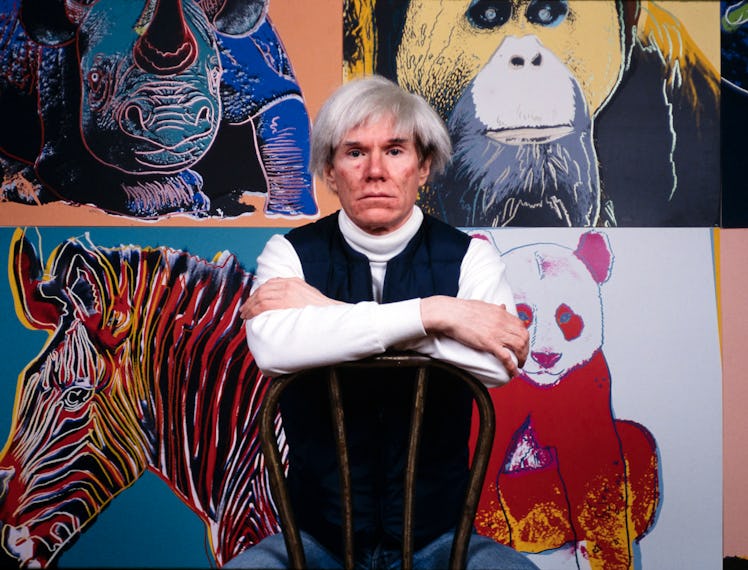
Tastemakers cycle in and out of the collective consciousness, with the rare exception of a few who become mainstays, weathering the whims and follies of fleeting trends. One such artist, Andy Warhol, would probably be delighted that he has long surpassed his allotted fifteen minutes of fame. For the better part of a century, his star has continued to rise, casting a halo on any who sparkled in his constellation—there have been countless movies, songs, and novels that orbit his influence. And for good reason: At his best, Warhol was a provocateur, probing the limits of art, film, and attitude with equal measure.
Many in his galaxy plummeted back to earth eventually—perhaps cloaking him, his superstars, and hangers-on in even more mystery and fascination. Ostensibly the first influencer, Warhol curated friends and aesthetics as he might an exhibit. He fractured taboos, openly scaled social ladders, and in his art, satirized historically lauded institutions. An enigma to the brim, the more layers peeled back in an attempt to understand the man, the more murky or out-of-focus he can become. But it’s a worthwhile effort. To embark on such a feat, be sure to start here, a shortlist of the most in depth and telling books on Andy Warhol and his social circle.
Published in 2020, esteemed art critic Blake Gopnik applied his encyclopedic knowledge of art history and penned arguably the most exhaustive biography on Andy Warhol. Using the artist’s archive, Gopnik sketches perhaps one of the clearest images of all Warhol’s dimensions and contradictions. While some biographies focus on a certain component or era of Warhol, Gopnik tackles the challenge with gusto, weaving together Warhol’s enigmatic personality, work, and lasting impact.
Who was the Warhol superstar who inspired Lou Reed, Andy Warhol, and The Rolling Stones alike? Finally, a biography on Candy Darling has been published. This book has everything: juicy gossip, extensive research, and above all, unequivocal glamor. The actress may have been an accidental pioneer, but she was a devoted starlet, living her truth while unknowingly paving the way for others. This new release will have you giggling on one page and sobbing by the next.
If you’ve watched the Netflix series of Warhol’s diaries, you know that your bookcase needs a hard copy, too. Warhol fans may never have the satisfaction of enjoying a traditional autobiography, but his diaries more than satisfy. While many had thoughts on the artist, he too had plenty of others of his own. From snippy commentary on socialites to thoughtful reflections on culture, Warhol was the ultimate observer. Fortunately for us, he dictated some of these to Hackett beginning in the mid ’70s until his death.
This isn’t the story of a bunch of Beatniks searching for enlightenment on the transcontinental highway. Instead, this is a real tale of an artist making his way across the country, encountering many of the symbols and hallmarks of Americana that he would later capture and examine in his work. Perhaps like many—even those maniacal Beats—Warhol took to the road as a young man, eager to experience the country the best way possible: from the asphalt up.
With her aristocratic pedigree, doe-like eyes, and penchant for eschewing pants, Edie Sedgewick was an “It” girl from the start. But it wasn’t until she joined forces with Andy Warhol that she hit the world stage, commanding it from the palm of her hand. In this biography, Stein digs below the caked-on eyeliner and headline-catching drama, and takes a compassionate look at Sedgewick’s childhood, her desires, and, yes, betrayal by one of her closest friends.
Warhol checks the lighting for Beauty #2, a picture featuring—and verbally dissecting—the vulnerable underground movie (and Factory) star Edie Sedgwick, left.
To map Warhol’s meteoric rise, perhaps it’s best to leave it to him to tell you how it happened. So it goes in “Popism: The Warhol Sixties,” a firsthand account of Warhol’s foray into the New York art world, constructing the Factory, and all the superstars he anointed within its foiled walls.
Published at the end of last year, Jones presents a complete history of the rise—and downfall—of The Velvet Underground, the brainchild of Andy Warhol. In its pages, readers will marvel at how the clashing personalities, particularly of Lou Reed and John Cale, were able to craft some of the most arcane rock music that’s still in rotation. With their monochromatic style, unapologetically obscure affect, and mixed-gender lineup, The Velvets demonstrated how to elevate rock music to become something entirely new.
Looking for more? Add these to your TBR pile to stock up.
“Warhol on Basquiat: The Iconic Relationship Told in Andy Warhol’s Words and Pictures” Edited by The Andy Warhol Foundation and Michael Dayton Hermann
“Fame” by Andy Warhol
“Famous for 15 Minutes: My Years with Andy Warhol” by Isabelle Dufresne (Ultra Violet)
“Factory Made: Warhol and the Sixties” by Steven Watson
“Swimming Underground: My Years in the Warhol Factory” by Mary Woronov